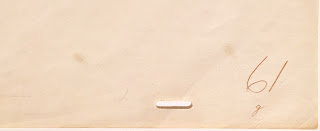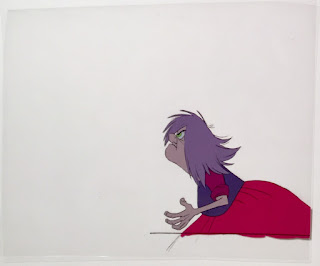Original hand painted and hand inked production animation cels of Sylvester and Tweety from a cartoon short, 1945-1956; Set on a lithographic background; Warner Bros. Studios; Hand signed in ink by Mel Blanc, Friz Freleng, and Virgil Ross lower left and lower center; Size - Sylvester: 3 3/4 x 3 1/2", Tweety: 2 x 1", Image 7 3/4 x 11 1/4"; Frame 18 1/2 x 21 3/4"; Framed with four acid free mats, UV conservation clear glass, and a blue wood frame.
"I tawt I taw a putty tat!" - Tweety
"Merrie Melodies" was originally produced by Harman-Ising Pictures from 1931-1933, and then Leon Schlesinger Productions from 1933-1944. Schlesinger sold his studio to Warner Bros. in 1944, and the newly renamed Warner Bros. Cartoons continued production until 1963. "Merrie Melodies" was outsourced to DePatie-Freleng Enterprises and Format Films from 1964 to 1967, and Warner Bros. Cartoons resumed production for the final two years.
Three of the "Merrie Melodies" films (Tweetie Pie, Speedy Gonzales, and Birds Anonymous) won the Academy Award for Best Animated Short Film and another three (Duck Amuck, One Froggy Evening, and What's Opera, Doc?) have been inducted into the National Film Registry of the Library of Congress.
Sylvester J. Pussycat, also known as Sr., Sylvester the Cat, Puddy Tat, or simply Sylvester; is an animated anthropomorphic cat from the Looney Tunes and Merrie Melodies series of cartoons. He is often chasing Tweety Bird, Speedy Gonzales, or Hippety Hopper. The name "Sylvester" is a derivation of Felis silvestris, the scientific name for the wild cats. Sylvester first appeared in Friz Freleng's Life With Feathers, 1945 and in the 1947 cartoon Tweetie Pie which was the first pairing of Tweety with Sylvester. Sylvester would appear in 103 cartoons during the Golden Age of animation, and three of his cartoons won Academy Awards (Tweetie Pie, Speedy Gonzales, and Birds Anonymous); the most for any starring Looney Tunes character! Sylvester was voiced by Mel Blanc from 1945 to 1988.
Tweety (short for Tweety Bird or Tweety Pie) is an animated yellow canary in the Warner Bros. Looney Tunes and Merrie Melodies series of cartoons. Tweety appeared in 47 cartoons during the Golden Age of animation, and legendary artist Mel Blanc originated the character's voice. Even after the cartoon shorts came to an end, Blanc continued to voice the character in TV specials, commercials, music recordings, and films, such as 1988's Who Framed Roger Rabbit; which was one of Blanc's final projects as Tweety.
Melvin Jerome "Mel" Blanc (May 30, 1908 – July 10, 1989) was an American voice actor, actor, radio comedian, and recording artist. He began his 60-plus-year career performing in radio, but he is best remembered for his work in animation as the voices of Bugs Bunny, Daffy Duck, Porky Pig, Tweety Bird, Sylvester the Cat, Yosemite Sam, Foghorn Leghorn, Marvin the Martian, Pepé Le Pew, Speedy Gonzales, Wile E. Coyote, Road Runner, the Tasmanian Devil, and many of the other characters from the Looney Tunes and Merrie Melodies cartoons during the Golden Age of American animation. He was the voice for all of the major male Warner Bros. cartoon characters
except for Elmer Fudd, whose voice was provided by fellow radio actor
Arthur Q. Bryan (although Blanc later voiced Fudd, after
Bryan's death). Mel Blanc earned the nickname "The Man of a Thousand Voices," and is regarded as one of the most influential people in the voice-acting industry.
Virgil Walter Ross (August 8, 1907 – May 15, 1996) was an American artist, cartoonist, and animator best known for his work on the Warner Bros. animated shorts. He first worked in animation for Walter Lantz, but then in 1935, he moved on to work for Leon Schlesinger at Warner Bros. where he spent about 30 years. He was first under Tex Avery's supervision, until 1942, then for Bob Clampett, and finally worked with Friz Freleng. Virgil Ross stated, "I always had an eye for movement, and I think this kept me in the
business a lot longer than a lot of guys, despite the fact that I really
wasn't very good at drawing. When I started out in animation, you
didn't have to be a good artist. I just had a little natural talent, and
it's mostly just timing anyway."
Ross animated many characters including Daffy Duck, Yosemite Sam, Tweety, Road Runner, and Wile E. Coyote; but he is most closely associated with Bugs Bunny. "We received orders from the story department that they needed a drawing of a bunny. We all did drawings and tacked them on the wall, and the storymen voted on them. We had one writer named Bugs Hardaway, and for some reason, this one drawing became known as Bugs' Bunny. Leon Schlesinger liked the sound of the name and told them to keep it, and that's how Bugs Bunny got his name. Years later, before he died, Hardaway tried to get some credit for making the character, which he probably deserved. But Warner Bros owned the rights to everything we created." - Virgil Ross
Isadore "Friz" Freleng (1906-1995) was an American animator, cartoonist, director, producer, and composer known for his work on the Warner Bros. Looney Tunes and Merrie Melodies cartoons. The nickname "Friz" came from his friend, Hugh Harman, who
nicknamed him "Congressman Frizby" after a fictional senator who
appeared in satirical pieces in the Los Angeles Examiner newspaper. Over time, the name was shortened to simply "Friz".
Friz Freleng created and/or developed several of the biggest animated character stars, including Bugs Bunny, Porky Pig, Tweety Bird, Sylvester the Cat, Yosemite Sam, and Speedy Gonzales. Freleng directed 256 cartoons, and is the most honored of the Warner Bros. directors; having won five Academy Awards and three Emmy Awards. After the Warner Bros. Studios shut down the animation studio in 1963, Freleng and business partner David H. DePatie founded DePatie-Freleng Enterprises. The newly formed animation studio would go on to produce many successful cartoons including The Pink Panther Show, feature film title sequences, and many Saturday-morning cartoons through the early 1980s.
This is an early set of original production cels of Sylvester and Tweety from the Golden Age of animation. What makes them even more wonderful is that they have been hand signed by the characters voice actor, Mel Blanc, their animator Virgil Ross, and the most honored Warner Bros. director Friz Freleng! Both Sylvester and Tweety are full figure, eyes open, and this is a beautiful piece of Golden Age American animation art!
Friz Freleng created and/or developed several of the biggest animated character stars, including Bugs Bunny, Porky Pig, Tweety Bird, Sylvester the Cat, Yosemite Sam, and Speedy Gonzales. Freleng directed 256 cartoons, and is the most honored of the Warner Bros. directors; having won five Academy Awards and three Emmy Awards. After the Warner Bros. Studios shut down the animation studio in 1963, Freleng and business partner David H. DePatie founded DePatie-Freleng Enterprises. The newly formed animation studio would go on to produce many successful cartoons including The Pink Panther Show, feature film title sequences, and many Saturday-morning cartoons through the early 1980s.
Framed production animation cels of Sylvester and Tweety hand signed by Mel Blanc, Friz Freleng, and Virgil Ross.
This is an early set of original production cels of Sylvester and Tweety from the Golden Age of animation. What makes them even more wonderful is that they have been hand signed by the characters voice actor, Mel Blanc, their animator Virgil Ross, and the most honored Warner Bros. director Friz Freleng! Both Sylvester and Tweety are full figure, eyes open, and this is a beautiful piece of Golden Age American animation art!
#Sylvester #SylvesterandTweety #Tweety #TweetyPie #TweetyBird #Sylvesterthecat #BugsBunny #MerrieMelodies #WarnerBros #EliotNess #VirgilRoss #GerryChiniquy #BobMatz #ArtLeonardi #LeeHalpern #ACME #LooneyTunes #FrizFreleng #MelBlanc #RalphJames #WalterWinchell #HarmanIsing #DaffyDuck #PorkyPig #ElmerFudd #LeonSchlesinger #Schlesinger #DePatieFreleng #cel #animation #cartoon #animationcel #animationdrawing #productioncel #productiondrawing #untitledartgallery


































